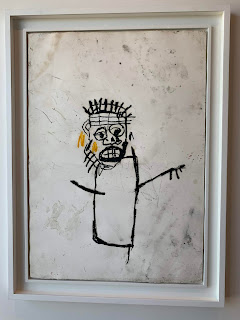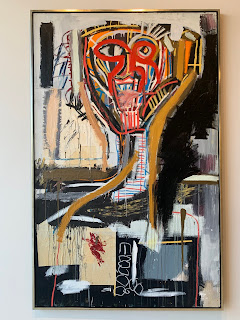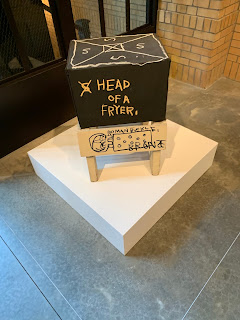 |
| Jean-Michel Basquiat By Source, Fair use, https://en.wikipedia.org/w/index.php?curid=29602496 |
The Brant Foundation
The mission of the Brant Foundation is to support contemporary artists and, towards that end, it exhibits their works at two locations. The newest location (Greenwich being the other) is 421 East 6th Street in NYC, a 100-year-old building which was initially built as a Con Edison substation and, subsequently, served as the home and studio of the artist Walter de Maria from the mid-1980s until his death in 2013.
The building has been renovated by Gluckman Tang Architects, at the behest of the Brant Foundation, wherein 7,000 of its 16,000 square feet is dedicated to exhibition space distributed over four floors.
 |
| Brant Foundation NYC location |
The Artist
Brant Foundation describes Basquiat on a wall panel on the ground floor of the exhibit:
At the onset of the 1980s, Jean-Michel Basquiat (1960 - 1988) took the art world by storm, with his powerful and highly complex works captivating, first Downtown New York, and then Europe and the rest of the world. Radical in both his artistic practice and life, Basquiat made the streets of Lower Manhattan his studio, joining the creative outpour that was emerging in the late 1970s and 80s in New York City. ... In the space of less than a decade, he achieved a comprehensive oeuvre -- consisting of more than 1,000 paintings and over 2,000 drawings -- marked by rapid and thunderous success virtually unknown by any other artist. A success which continues to grow, exponentially, to this day and solidifies him as one of the greatest artists of our time.What had brought this son of a Haitian father and Puerto Rican mother, this drug-using, high-school dropout, from the streets of the Lower East Side to the upper echelons of the art world?
Basquiat was born in Brooklyn in 1960. One of the seminal events in his youth was being hit by a car in the street of his residence, necessitating a lengthy rehabilitation. During his rehab, his mother gave him a copy of the Book Gray's Anatomy which he studied assiduously. The influence of that book is apparent in much of his art.
Jean-Michel dropped out of school prior to graduation and fell into the graffiti culture which was then taking off in Brooklyn and the Bronx. He tagged with a fellow artist under the moniker Samo© but when they fell out, he killed off the designation.
New York City was falling apart at this time. It was deep in debt and awash in deserted and abandoned buildings. The cheap rent attracted artists to the Lower East Side and this mish mosh of practitioners from all branches of the arts yielded a unique, gritty culture. Basquiat fell right into this, steering away from graffiti and wanting to be considered an artist.
During this time he could not afford art supplies so he painted on anything that was available -- scraps of paper, doors from abandoned buildings, etc. His artistic skills began to be noticed but his sprint to the top really began with his participation in the January 1981 art show at PS1 in Queens that was organized by Diego Cortez. Basquiat's path to stardom post that meeting is shown in the chart below.
Cathleen McGuigan (New York Times, 2/10/85) provides a comprehensive description of Basquiat's paintings:
His color-drenched canvasses are peopled with primitive figures wearing menacing, masklike faces, painted against fields jammed with arrows, grids, crowns, skyscrapers, rockets and words ... His drawings and paintings are edgy and raw, yet they resonate with the knowledge of such modern masters as Dubuffet, Cy Twombly or even Jasper Johns.Table 1. Characterizing Basquiat's talent
| Name | Profession | Assessment |
| Sandro Chia (after the PS1 show) | Painter (Italian) | “Basquiat’s paintings captured the spontaneity of the City” “The paintings were full of disparate elements that somehow worked together though there was no apparent system linking them” |
| John Russell | Chief art critic, New York Times | “Basquiat proceeds by disjunction — that is by making marks that seem quite unrelated, but that turn out to get on very well together” |
| Vivian Raynor | New York Times Writer | “The educated quality of Basquiat’s line and the stateliness of his compositions both of which bespeak a formal training that, in fact, he never had.” |
Jean-Michel Basquiat died of an overdose in 1988. He was 28 years old.
The Exhibition
As I mentioned previously, through perseverance, I was able to obtain a ticket to the sold-out exhibition. My entry time was 12:45 but, as I was driving into the City, I got there well before my appointed time. The person monitoring the entry was sympathetic and allowed me in.
I stepped into the ground floor of the building and my ticket was scanned by one of the two or three interns who were assigned this task. I was then directed on to an elevator which would take me to the fourth floor as the exhibition was spread over four floors and was routed from the topmost to the lowest floor. I am still not clear why individual paintings were placed on specific floors.
The paintings on the 4th and 3rd floors had wall cards which indicated the name of the painting (or untitled) and the year of its creation. This practice was abandoned for the final two floors. On each floor there was an i-pad like device which had additional information on the paintings in that area but it was inconvenient because it could only serve one reader at a time.
In that I got there before the official museum opening time, I was able to step right in and view the paintings with relative ease. By the time I concluded my walk-through, there was a lengthy line outside the building waiting for entrance.The look of reverence on the faces of the viewers spoke to the standing that Basquiat has attained in the art-loving community.
The art work of Jean-Michel is captivating. It pulls you in, taking you ever deeper into its essence. The figures are child-like and primitive but there is a depth and complexity that defies your brain as you attempt to compartmentalize and allocate. The works are electric and vibrant, thanks to his use of color. The masters of surrealism sought to paint images derived from their dream states on canvas; one wonders from whence did these images emanate.
I captured most of the pieces in the exhibition on my iPhone and I reproduce them below. I am still continuously scrolling through them, captivated by the unknown, by the emotions that these almost cave-art-like paintings evoke.
 |
| Untitled (Self-Portrait), 1982 Oilstick and ink on paper |
 |
| Untitled (Man with Microphone), 1982 Oilstick on paperboard |
 |
| Per Capita, 1981 Acrylic and oilstick on canvas |
 |
| Arroc con Pollo, 1981 Acrylic and oilstick on canvas |
 |
| Warrior, 1982 Acrylic and oilstick on wood panel |
 |
| Untitled, 1982 Acrylic, oilstick, and spray paint on wood |
 |
| Untitled, 1982 Acrylic, oilstick, and spray paint on wood |
 |
| Untitled, 1981 Acrylic and oilstick on canvas |
 |
| Untitled (tenant), 1982 Acrylic and oilstick on canvas |
 |
| Self-Portrait with Suzanne, 1982 Oilstick on paperboard |
 |
| Untitled (Cars/Teepees), 1981 Oilstick on paper |












































No comments:
Post a Comment